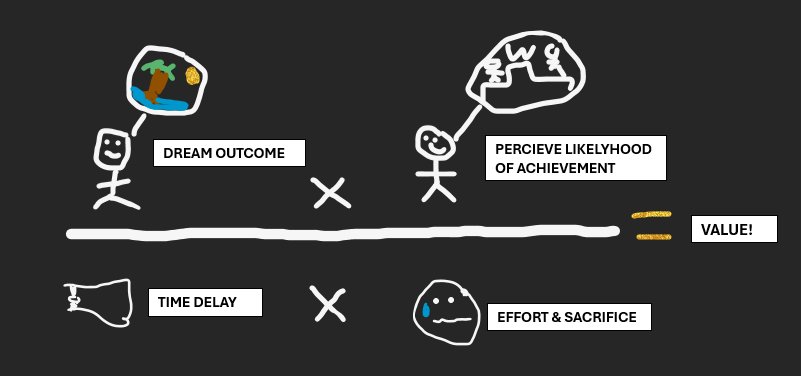How Hormozi’s Value Equation Works
In the competitive world of business, understanding and delivering value is paramount. Alex Hormozi, a renowned entrepreneur and author, has devised a straightforward yet profound framework to elucidate this concept: The Value Equation. By breaking down the elements that contribute to perceived value, Hormozi’s equation offers a clear pathway for businesses to enhance their offerings and better meet customer needs. This blog will delve into the intricacies of Hormozi’s Value Equation, exploring its components and practical applications.
The Anatomy of the Value Equation
Hormozi’s Value Equation can be succinctly expressed as:

Each component of this equation plays a crucial role in determining the overall value a customer perceives in a product or service.
1. Dream Outcome
The “Dream Outcome” represents the ultimate result that a customer desires. This is the pinnacle of what they hope to achieve through your product or service. For example, in the fitness industry, the dream outcome might be achieving a sculpted physique or significant weight loss. Understanding your customer’s dream outcome is essential because it forms the foundation of your value proposition. The more your product aligns with their aspirations, the higher the perceived value.
2. Perceived Likelihood of Achievement
Even if a product promises an incredible outcome, customers need to believe that it will work for them. The “Perceived Likelihood of Achievement” reflects the customer’s belief in the product’s effectiveness. This perception can be influenced by factors such as testimonials, case studies, endorsements, and the credibility of your brand. By enhancing this perception, businesses can significantly increase the value their customers attribute to their offerings.
3. Time Delay
The “Time Delay” component addresses how long it takes for the customer to achieve their dream outcome. In today’s fast-paced world, quicker results often translate to higher perceived value. For instance, a rapid weight loss program or a quick-acting pain relief medication would typically be valued more highly than their slower counterparts. Reducing the time delay enhances the appeal of a product, making it more attractive to potential customers.
4. Effort and Sacrifice
Finally, “Effort and Sacrifice” consider what the customer must endure to achieve the dream outcome. This includes not only the physical effort and time commitment but also financial costs and potential lifestyle changes. Products or services that minimize effort and sacrifice are generally perceived as more valuable. For example, a meal delivery service that provides healthy, ready-to-eat meals with minimal preparation required will likely be valued more highly than one that requires extensive cooking.
Practical Applications of the Value Equation
Hormozi’s Value Equation offers a powerful framework for businesses to analyze and enhance their value propositions. Here’s how you can apply it:
1. Identify and Amplify the Dream Outcome
Start by clearly identifying the dream outcomes of your target customers. Conduct surveys, focus groups, and market research to understand their deepest desires and aspirations. Once identified, craft your marketing messages to highlight how your product or service can deliver these dream outcomes.
2. Boost Perceived Likelihood of Achievement
To enhance the perceived likelihood of achievement, leverage social proof. Showcase testimonials, before-and-after photos, and success stories prominently on your website and marketing materials. Partner with credible influencers or experts in your industry to endorse your product. Ensure that your branding and messaging convey trust and reliability.
3. Minimize Time Delay
Look for ways to reduce the time delay between purchase and the realization of the dream outcome. This might involve streamlining your processes, offering faster shipping, or providing immediate access to digital products. Communicate clearly about how quickly customers can expect to see results.
4. Reduce Effort and Sacrifice
Analyze the customer journey and identify pain points where effort and sacrifice are required. Simplify and automate processes wherever possible. Offer comprehensive support and resources to help customers navigate any challenges. Consider pricing strategies that minimize the financial burden on your customers.
Conclusion
Hormozi’s Value Equation provides a robust framework for understanding and enhancing the value you offer to customers. By focusing on delivering dream outcomes, boosting the perceived likelihood of achievement, minimizing time delays, and reducing effort and sacrifice, businesses can significantly increase their value proposition. Applying these principles will not only attract more customers but also foster loyalty and drive long-term success. In the end, the Value Equation is not just a theoretical concept but a practical tool for creating exceptional customer experiences and thriving in a competitive marketplace.
